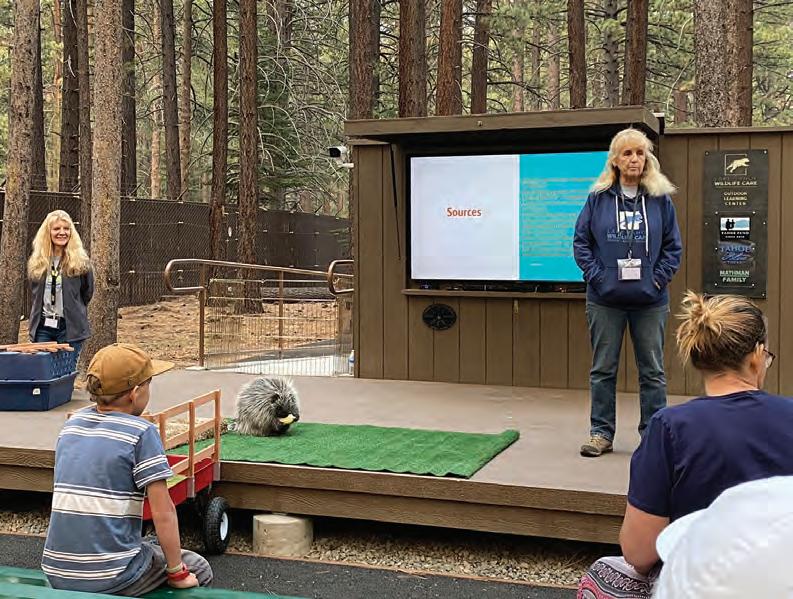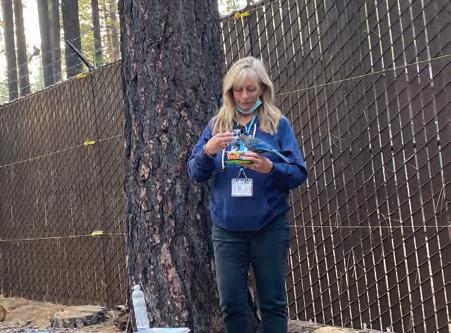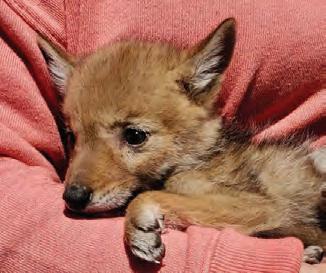
6 minute read
Lake Tahoe Wildlife Care
GEToutside
the outdoors | recreation | events | mountain life
Advertisement
Lake Tahoe Wildlife Care
RESCUING, REHABBING TAHOE’S WILDLIFE
On a cool, end-of-the-summer evening, Lake Tahoe Wildlife Care in South Lake Tahoe hosts its weekly Wildlife Wednesday on a newly built outdoor stage.
At the new Outdoor Learning Center, made possible by donations from Tahoe Fund and Tahoe Blue Vodka, volunteers educate the public about Tahoe wildlife, the nonpro t’s mission and the public’s role in keeping native animals safe and healthy. Shortly after the outdoor amphitheater’s opening, Lake Tahoe Wildlife started hosting free public events.
STORY & PHOTOS BY KAYLA ANDERSON
Lake Tahoe Wildlife Care has received bald eagles, mountain lions, bear cubs and even a mountain beaver that was brought in by a valet parking attendant from one of the local casinos.

On this particular Wednesday, animal care director Denise Upton shares the center’s beginnings and its goal to rescue, rehabilitate and release animals back into the wild. Founded in 1978, the organization takes in around 130 di erent species of birds and animals a year. ey have received bald eagles, bear cubs and even a mountain beaver that was brought in by a valet parking attendant from a local casino.
“I really enjoy [releasing the animals] because that means we did our job,” she says.
WILD & FREE AUCTION
OCT. 21 | VIRTUAL REGISTER LTWC.ORG/EVENTS
DOES AN ANIMAL NEED HELP?
When coming across an injured animal, Upton says that residents and visitors should ask themselves if the animal really needs to be saved before removing it and calling Lake Tahoe Wildlife. e organization receives about 60 to 70 calls a day in the high season and many times an animal doesn’t need rescuing. For instance, in the springtime when edglings leave their nests, it’s a bit awkward when they rst take ight. ey bounce on the ground and stumble around, but usually the mom is close by. e worst thing to do try to save it when it’s just trying to learn how to y.
KEEPING ANIMALS WILD

e animals at the center are taught to stay away from humans and forage for food in the forest on their own; the birds are ight tested before being released. e sad truth is that if an animal cannot make it on its own in the wild, then it will likely be euthanized. Lake Tahoe Wildlife hopes to build a larger rehabilitation center and hospital and create an animal sanctuary in the future, using more of its 27-acre property.
“We hope people can come here to see a bear instead of trying to bait it to get a picture for Facebook out in the wild,” Upton says.
As part of the presentation, wildlife rehabilitation manager Jenny Curtis gives a quick talk about bears, describing how smart they are, how they use their senses and how to e ectively cohabitate with them. As she talks, a stellar jay starts divebombing people. It eventually lands on the hand of a volunteer, who keeps the quirky, demanding bird occupied with food.
THE MISUNDERSTOOD COYOTE
Finally, sta member Kassie Quackenbush talks about her favorite animal in the Tahoe Sierra – the coyote.
“I think they’re fun, interesting and misunderstood,” she says. “It’s best to think of them as raw, wild dogs.”
Porky the Porcupine and Denise Upton; Coyote pups in the center’s care; A Lake Tahoe Wildlife Care volunteer feeds a divebombing blue jay.
She explains how they evolved in North America and as part of the canine family, they are a mix between a wolf and a dog.
She describes their 11 di erent vocalizations and how it’s a common misconception that when people think they’re hearing a pack of coyotes howl, it’s usually just one or two.
“ ey just have strong voices,” she says.
According to Quackenbush, the 19 subspecies of coyotes are monogamous and hunt alone. ey make good cleanup crews and pest controllers. ey eat roadkill and disease-ridden rodents — both behaviors inadvertently help keep water sources safe. e coyote pups currently living at the center are left alone by volunteers, who do not interact with them because the goal is to be able to release them back into the wild. In a timely coincidence, a coyote runs across the parking lot as she talks. e entire presentation was interesting, interactive and fun. We were introduced to a special guest, a porcupine named Porky that delighted and entertained the kids and adults alike.
Ironically, early the next morning at 3:30 a.m., I awoke to what sounded like a pack of wolves in my driveway. In my sleepy state, I thought, “ at’s probably just one coyote; it does have a strong voice.” | (530) 577-2273, ltwc.org
Trail access limited, lifts damaged
–Katherine E. Hill Most U.S. Forest Service districts have reopened in the Tahoe Sierra, but with the Caldor Fire still only 76 percent contained as of press time and fi re danger still high throughout the region, some forest areas and trails remain closed to the public.
Sierra-at-Tahoe has also reported damage to two lifts at the ski area from the Caldor Fire.
“Nob Hill and Short Stuff have sustained damage to varying degrees. When the fi re crews wrap up their work, we will be able to really get in and understand more about the level of repair needed and the timeline related to how quickly that can happen,” the resort reported in a post on Facebook, noting that it has been unable to do a full assessment of the property yet. Follow updates @SierraAtTahoe
Trail damage | Tahoe Area Mountain Biking Association is also reporting damage to more than 20 miles of trails on the South Shore including Mr. Toad’s Wild Ride, Corral Trail, Sidewinder, Incense Cedar, Armstrong Connector and Armstrong Pass Trail.
“We have begun assessing damage to trails via satellite data and also from some TAMBA members/volunteers who are local fi refi ghters and have been providing us information on some of the impacts to the trails,” said Patrick Parsel, trails coordinator for TAMBA in a Facebook post. “Some of the most popular mountain bike trails in the Tahoe Basin burned during the Caldor Fire.” Follow updates at @TAMBAtahoe
Forest closures | Portions of the Lake Tahoe Basin Management Unit are closed through Dec. 31 due to the Caldor Fire including areas around Fallen Leaf Lake and the South Shore.
The Eldorado National Forest remains closed until Sept. 30. Portions of the Plumas National Forest near the Dixie and Beckwourth fi res are closed until Nov. 30. Details on all closures at fs.usda.gov
State parks | All state parks around Lake Tahoe have reopened. Spooner Lake’s main entrance remains closed for parking enhancements, but trail access is open.
Trail closures | Portions of the Tahoe Rim Trail and Pacifi c Crest Trail remain closed due to fi re danger and Forest Service closures. | tahoerimtrail.org
Back-country | Back-country area closures have been extended until Oct. 20 for Desolation Wilderness, Meiss Backcountry, Barker Pass and McKinney/ Rubicon. Visit fs.usda.gov for details and closure maps.



